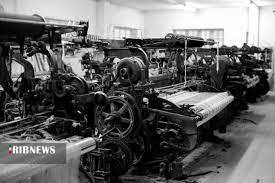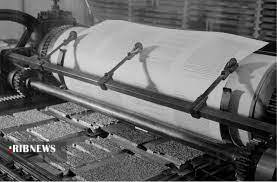The printing industry is a cultural, artistic and industrial phenomenon that has always contributed to the growth and development of human societies since its inception.
The German inventor Johannes Gutenberg invented the first printing machine in 1440, which can be considered the beginning of the modern journalism industry. The basis of this invention was the molding of movable letters that were made of metal alloys. Although before Gutenberg, in Chapin and Korea, types of movable printing had been invented, but this invention of the German man industrialized printing; It created a huge revolution in the printing industry and reduced printing costs to a great extent. Gutenberg printed the calendar for that year in 1448, and since then, this tradition has continued every year.

Gutenberg’s invention greatly increased the amount of printed writing in Europe. Before that, it took 10 to 15 years in monasteries and monasteries in the Middle Ages in Europe to give a copy of the Bible to those who were interested. The same thing happened in Asian and Muslim countries. Lenski and Lenski writes: “According to one historian, the only books that were published in the first 50 years after the invention of the printing press were many times more than all the books that the writers of Europe had created during the previous one thousand years.
The revolution that this industry created was the printing of treatises on the education of Protestant reformers. By printing their views and opinions and publishing them in a large amount day by day, the number of those who believed in them increased and the number of those who believed in them increased. Historians today consider the printing press as one of the main factors in the expansion of this religious movement. Protestant reformers emphasized that people should be able to read the Bible by themselves in order to obtain the word of God without any intermediary. Therefore, literacy in Protestant societies took on a new concept and was removed from luxury and aristocratic status and became a duty of every religious person. With the increase of literate people, the society moved towards development more rapidly.
The printing industry can be referred to as the printing super industry. In the creation of major global revolutions including the cultural revolution of the Renaissance, the scientific revolution, the political-social revolution of the 18th to the end of the 20th centuries, such as the French, American, Russian, and Chinese revolutions, the scientific revolution for the establishment of schools and universities, the telecommunications and electronics revolution. And the digital revolution and technology has had a special role and place.
In all human revolutions, the printing industry has had a special and special place that if it wasn’t there; Human revolutions, which created a part of social development, did not emerge.
Background of the printing industry in Iran

The history of printing in Iran goes back to five centuries BC, that is, to the time of the Achaemenid kings and royal seals, which were used to confirm government decrees and decrees. The entry of the word “printing” into the Persian language is attributed to the end of the 7th century of Hijri and the reign of Gikhatokhan, the son of Abaqa Khan Mughal (690-694 AH) and it was related to paper money that was called chao or ka o. It was the first printing machine in Iran. This device was very simple and was based on a press and engraving on leather.
The first printing house in Iran dates back to the Safavid era, when Armenian priests in Jolfa, Isfahan printed a number of Christian prayers and zikrs. During the reign of Nader Shah Afshar, according to the report of two foreign tourists, pamphlets in Latin and Arabic were printed and distributed in Iran. But during the reign of Abbas Mirzai, the viceroy, the printing industry in Iran began seriously. During the time of Feth Ali Shah Qajar, Abbas Mirza became acquainted with some Ottoman industries due to the establishment of his government in Tabriz; In addition, he wanted military and political developments, especially for the education and training of the corps defeated in the wars with Russia and other necessary sciences, in order to overcome the noticeable backwardness at that time; Meanwhile, there was a need for a printing house dedicated to publishing newspapers and informative books, especially scientific books. This task was finally achieved with his support and follow-up. In this way, he founded the first printing house in Iran, which published books in Persian language using lead printing method. The printing industry that flourished day by day and had an undeniable role in the constitutional movement and the victory of the Islamic revolution.
Since the formation of the constitutional movement, we have witnessed many times the presence of the printing industry in political activities such as printing statements, Shabnameh, newspapers and books. We have to admit that in a world where there was no internet, no satellite or television, the emergence of the printing industry was undoubtedly a revolution in information, and its impact on the great political, religious and economic revolutions and reforms of the past centuries cannot be ignored.
Also, the beginning of Imam Khomeini’s activities in 1342 and the beginning of serious struggles, access to Imam, who was addressed as “Haj Agha Ruhollah” in those days, became less and he wrote his talks and opinions and gave them to his relatives and they They wrote several copies of it and distributed it at the community level, due to the large number of followers of the Imam (RA), this task faced a problem, and the revolutionaries were forced to publish the declaration through Amin’s printers and distribute it at the community level.
The trend of the printing industry today
The development of printing services in the world, despite the advancement of technology and facing the digital space, also faces limitations. The main reason for this is the spread of the Internet in almost all levels of society and the fast and low-cost transfer of information. Also, the emphasis of environmental activists and global policies to preserve natural resources and forests has placed requirements on cellulose and paper production industries, and the printing industry has not benefited from these requirements either! According to statistics and figures, the growth trend of the printing industry in developed markets has slowed down due to reaching its peak, while in developing markets and due to the existence of more capacities, it is still increasing rapidly. However, in all countries, subgroups of this industry, mainly in the fields of post-printing services such as packaging and envelope making, label printing, or outdoor printing, are facing more demand compared to other sectors. It is interesting to know that in 2018, the turnover of this industry in the field of printing services and post-printing services was reported to be around 1 trillion dollars. It should also be mentioned that in recent years, the growth of digital printing, especially in the advertising sector, catalog printing, brochures, etc., has also been able to increase the financial value of the markets related to the printing industry.

